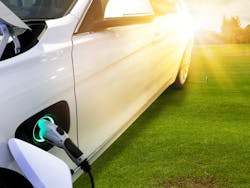California Awards $10.8M to Reuse EV Batteries in Solar & Microgrid Projects
The California Energy Commission (CEC) awarded $10.8 million to four projects that will explore repurposing used batteries from electric vehicles (EV), partly to support microgrids.
By Smile Fight/Shutterstock.com
The awards approved in meetings in June and July stemmed from a solicitation for research and development projects showing how used batteries could cost-effectively integrate solar at small-to-medium commercial buildings.
With a goal of having 5 million zero-emission vehicles on the road by 2030, the commission is looking for ways to give degraded car batteries a second life. Typically, EV batteries are retired when they lose 70 percent to 80 percent of their capacity. However, they can be used for other applications like energy storage.
On July 10, the commission gave San Diego State University Research Foundation $2.8 million to install EV battery packs at two facilities that have solar panels and the agency awarded ReJoule $3 million to develop a tool to test repurposed batteries to make sure they are safe.
The commission a month earlier awarded RePurpose Energy a $3 million grant and Smartville a $2 million grant.
Identifying battery health
The SDSU research project involves installing used electric vehicle battery packs at two sites that have solar panels. One site — the Chula Vista Veterans Park in Chula Vista, California — has a 56-kW photovoltaic system that supplies 70 percent of the facility’s electricity, according to a commission summary of the grant. To meet its critical load needs during a 24-hour power outage, the facility needs about 280-kWh of storage, or roughly four to 10 used EV battery packs.
The second site — the SDSU Children’s Center in San Diego — has a 60-kW solar system, supplying about half the building’s electricity. The site needs a 320-kWh of storage capacity to meet a day-long power outage, or roughly five to 12 used EV battery packs.
This project focuses on developing technologies to identify battery health and optimize usage, according to the grant summary. The technologies include control and operation algorithms to support proactive maintenance, predictive thermal management, active cell balancing, and dynamic demand response management, the summary said.
“Together these technological advancements will extend the life of the repurposed EV batteries and lower the cost to the California rate payer,” the summary said.
Safety of used batteries
ReJoule intends to use the grant to develop a battery-grading tool for assessing and ensuring the safety of repurposed batteries, according to a commission summary of the grant. The company also plans to show how its battery management system can extend the life and performance of second-life batteries.
The technology will enable more accurate battery models and predictive battery health algorithms, which can extend battery life through load-balancing and real-time degradation modeling.
The project will be set up at two sites: Lucky Cat Labs, an artist’s studio in Los Angeles, and a homeless shelter in Santa Ana, California. The project will combine solar with used EV batteries controlled by CleanSpark’s mPulse software and controls platform and ReJoule’s battery management system.
ReJoule is working on the project with CleanSpark, Ford Motor Co., BigBattery and GRID Alternatives.
The RePurpose project is designed to show how combining solar with used EV batteries can provide energy resilience at a food cooperative in a low-income community in Grass Valley, California, affected by public safety power shutoffs.
The company is a spin-off from a successful CEC-funded second-life battery microgrid project conducted by University of California, Davis.
Smartville plans to show how hybrid systems can offer building resiliency and load shifting services. The project intends to validate a second-life battery system that can be used to “hot-swap” battery modules to limit a system’s downtime and optimize degradation control to improve. battery health over long-term use, according to commission staff. The company also wants to show the system can be used across different battery chemistries and manufacturers.
Track news about about repurposing used batteries from electric vehicles. Subscribe to the free Microgrid Knowledge newsletter.







